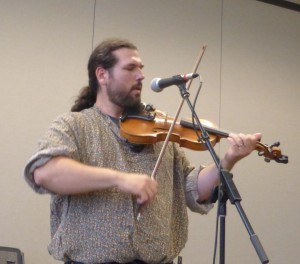Stroughmatt presents Illinois’ French heritage through music
Chronicle Media — June 19, 2015
Dennis Stroughmatt explained the history of the French in Illinois through the use of music at the Fondulac Library on June 17. Chronicle Media photo.
Dennis is a musician who became enamored with the French tradition in the mid-south when he was very young. Growing up in Edwards County (total population 7,000), he began a lifetime of studying French colonial music. Dennis owns several violins, two of which he brought to the Fondulac Library on June 17 for his performance as part of the library’s summer reading program. Using his violins and his Melodeon (small accordion), he demonstrated several tunes that are similar, but each with a different tempo or nuance. Having a fine singing voice, he sang several ballads – in Illinois French.
Dennis lives in the same area where he grew up, miles from any big city, with his wife and two children. As a member of the Roads Scholar project, he gives instructional performances throughout the country. The performance at the Fondulac Library was supported in part by the Illinois Humanities Council.
In the early days of our country the French populated the banks of major rivers: the Mississippi, Missouri, Ohio, Wabash. They had thriving communities all through southern Illinois, Missouri, and Louisiana. New Orleans remains a remnant of French occupation, but there are many other locations that retain a tinge of the French, where Americanized place names and surnames abound. And everyone knows about Creole and Cajun food.
Today the best places to see and feel the French influence are Ste. Genevieve and Old Mines in Missouri. Ste. Genevieve is known for its 300 year old French homes, and Old Mines is where you go to learn about the language, music and culture of the French in Illinois.
The word ‘Cajun’ is a derivative of ‘Acadian.’ The French who populated Nova Scotia. The French and the British were at war for a long time and when the British finally got the upper hand after the 7 Years War, they commanded that all the people swear allegiance to England, learn to speak English, and renounce Catholicism. Finding this too much to bear, the French of Nova Scotia refused, and the British expelled them in the late 17th century. People were packed on ships and sent south, being dropped off at ports from Maine to Virginia. In one way or another they made their way to the mouth of the Mississippi and established settlements in the land that was then ruled by Spain. To the American ear, the word ‘Acadian’ in French sounded like ‘cajun,’ so that’s what the French descendants were called.
The term ‘Creole’ originally meant anyone who was born of French or Spanish heritage but born in the United States. Thousands of refugees from French colonies in places like Saint-Dominque (now Haiti) and Cuba immigrated to Louisiana in the turmoil of the early 19th century. In Louisiana the term Creole represented children of black or racially mixed parents as well as children of French and Spanish descent who were not mixed-race. After the Louisiana Purchase in 1803 people who were of French and Spanish descent living in New Orleans and St. Louis called themselves Creole to distinguish themselves from Anglo-Americans who moved into the area.
To see and hear Dennis Stroughmatt in concert, visit the Library of Congress Homegrown Concert Series at ttps://www.youtube.com/watch?v=Heay7zhmC1w. Dennis was chosen as the very first artist to be featured in 2012.



